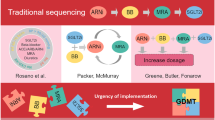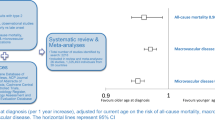Abstract
Purpose
Clinical trials have shown that evidence-based secondary prevention medications reduce mortality after acute myocardial infarction (AMI). Yet, these medications are generally underused in daily practice, and older people are often excluded from drug trials. The purpose of this study was to examine whether the relationship between adherence to evidence-based drugs and post-AMI mortality varies with increasing age.
Methods
The study population was defined as all residents in the Local Health Authority of Bologna (Italy) hospitalized for AMI between January 1, 2008 and June 30, 2011, and followed up until December 31, 2012. Medication adherence was calculated as the proportion of days covered (PDC) for filled prescriptions of angiotensin-converting enzyme inhibitors/angiotensin receptor blockers, β-blockers, antiplatelet drugs, and statins; patients were classified as adherent (PDC ≥75 %) or nonadherent (PDC <75 %). We used incidence density sampling, and the moderating effect of age on the relationship between adherence and mortality was investigated through conditional multiple logistic regression analysis.
Results
The study population comprised 3963 patients. During the 5-year study period, 1085 deaths (27.4 %) were observed. For both younger and older patients, adherence to polytherapy (three or four medications) was associated with lower mortality (adj. rate ratio = 0.41; P < 0.001). A significant inverse relationship was found between adherence to each of the four medications and mortality, although the risk reduction associated with antiplatelet therapy declined after the age of 70–75.
Conclusions
The beneficial effect of evidence-based polytherapy on mortality following AMI is observed also in older populations. Nevertheless, the risk-benefit ratio associated with antiplatelet therapy is less favorable with increasing age.


Similar content being viewed by others
Notes
Deaths from external causes, not included in the outcome measure, were 29 injuries of head, thorax, pelvis, hip, lower limb, or multiple body regions; 1 foreign body aspiration; and 1 sinus barotrauma.
References
National Institute for Health and Clinical Excellence (2007) MI—secondary prevention: secondary prevention in primary and secondary care for patients following a myocardial infarction. NICE clinical guideline 48. National Institute for Health and Care Excellence, London
Burwen DR, Galusha DH, Lewis JM, Bedinger MR, Radford MJ, Krumholz HM, Foody JM (2003) National and state trends in quality of care for acute myocardial infarction between 1994-1995 and 1998-1999: the Medicare health care quality improvement program. Arch Intern Med 163:1430–1439. doi:10.1001/archinte.163.12.1430
Ho PM, Magid DJ, Masoudi FA, McClure DL, Rumsfeld JS (2006) Adherence to cardioprotective medications and mortality among patients with diabetes and ischemic heart disease. BMC Cardiovasc Disord 6:48. doi:10.1186/1471-2261-6-48
Newby LK, LaPointe NM, Chen AY, Kramer JM, Hammill BG, DeLong ER, Muhlbaier LH, Califf RM (2006) Long-term adherence to evidence-based secondary prevention therapies in coronary artery disease. Circulation 113:203–212. doi:10.1161/CIRCULATIONAHA.105.505636
Gislason GH, Rasmussen JN, Abildstrøm SZ, Gadsbøll N, Buch P, Friberg J, Rasmussen S, Køber L, Stender S, Madsen M, Torp-Pedersen C (2006) Long-term compliance with beta-blockers, angiotensin-converting enzyme inhibitors, and statins after acute myocardial infarction. Eur Heart J 27:1153–1158. doi:10.1093/eurheartj/ehi705
Watts G (2012) Why the exclusion of older people from clinical trials must stop. BMJ 344:e3445
Hubbard RE, O’Mahony MS, Woodhouse KW (2013) Medication prescribing in frail older people. Eur J Clin Pharmacol 69:319–326. doi:10.1007/s00228-012-1387-2
Kirchmayer U, Agabiti N, Belleudi V, Davoli M, Fusco D, Stafoggia M, Arcà M, Barone AP, Perucci CA (2012) Socio-demographic differences in adherence to evidence-based drug therapy after hospital discharge from acute myocardial infarction: a population-based cohort study in Rome, Italy. J Clin Pharm Ther 37:37–44. doi:10.1111/j.1365-2710.2010.01242.x
Yan AT, Yan RT, Tan M, Huynh T, Soghrati K, Brunner LJ, DeYoung P, Fitchett DH, Langer A, Goodman SG (2007) Optimal medical therapy at discharge in patients with acute coronary syndromes: temporal changes, characteristics, and 1-year outcome. Am Heart J 154:1108–1115. doi:10.1016/j.ahj.2007.07.040
Kirchmayer U, Di Martino M, Agabiti N, Bauleo L, Fusco D, Belleudi V, Arcà M, Pinnarelli L, Perucci CA, Davoli M (2013) Effect of evidence-based drug therapy on long-term outcomes in patients discharged after myocardial infarction: a nested case-control study. Pharmacoepidemiol Drug Saf 22:649–657. doi:10.1002/pds.3430
Sanfélix-Gimeno G, Peiró S, Ferreros I, Pérez-Vincente R, Librero J, Catalá-López F, Ortiz F, Tortosa-Nácher V (2013) Adherence to evidence-based therapies after acute coronary syndrome: a retrospective population-based cohort study linking hospital, outpatient, and pharmacy health information systems in Valencia, Spain. J Manag Care Pharm 19:247–257
Suissa S (2008) Immeasurable time bias in observational studies of drug effects on mortality. Am J Epidemiol 168:329–335. doi:10.1093/aje/kwn135
National Institute for Health Excellence Care (2013) MI—secondary prevention: secondary prevention in primary and secondary care for patients following a myocardial infarction. NICE clinical guideline 172. National Institute for Health and Care Excellence, London
Ho PM, Bryson CL, Rumsfeld JS (2009) Medication adherence: its importance in cardiovascular outcomes. Circulation 119:3028–3035. doi:10.1161/CIRCULATIONAHA.108.768986
Austin PC, Tu JV (2004) Automated variable selection methods for logistic regression produced unstable models for predicting acute myocardial infarction mortality. J Clin Epidemiol 57:1138–1146. doi:10.1016/j.jclinepi.2004.04.003
Breslow NE (1996) Statistics in epidemiology: the case-control study. J Am Stat Assoc 91:14–28. doi:10.2307/2291379
Lapi F, Azoulay L, Yin H, Nessim SJ, Suissa S (2013) Concurrent use of diuretics, angiotensin converting enzyme inhibitors, and angiotensin receptor blockers with non-steroidal anti-inflammatory drugs and risk of acute kidney injury: nested case-control study. BMJ 346:e8525. doi:10.1136/bmj.e8525
Steg PG, James SK, Atar D, Badano LP, Blömstrom-Lundqvist C, Borger MA, Di Mario C, Dickstein K, Ducrocq G, Fernandez-Aviles F, Gershlick AH, Giannuzzi P, Halvorsen S, Huber K, Juni P, Kastrati A, Knuuti J, Lenzen MJ, Mahaffey KW, Valgimigli M, van’t Hof A, Widimsky P, Zahger D (2012) ESC Guidelines for the management of acute myocardial infarction in patients presenting with ST-segment elevation. Eur Heart J 33:2569–2619. doi:10.1093/eurheartj/ehs215
Mickley H, Eiskjaer H, Bøtker HE (2004) Is an additional post-myocardial infarction beta-blocker trial required in the era of early revascularization? Eur Heart J 25:96–97. doi:10.1016/j.ehj.2003.06.011
Moscucci M, Fox KA, Cannon CP, Klein W, López-Sendón J, Montalescot G, White K, Goldberg RJ (2003) Predictors of major bleeding in acute coronary syndromes: the Global Registry of Acute Coronary Events (GRACE). Eur Heart J 24:1815–1823. doi:10.1016/S0195-668X(03)00485-8
Roe MT, Goodman SG, Ohman EM, Stevens SR, Hochman JS, Gottlieb S, Martinez F, Dalby AJ, Boden WE, White HD, Prabhakaran D, Winters KJ, Aylward PE, Bassand JP, McGuire DK, Ardissino D, Fox KA, Armstrong PW (2013) Elderly patients with acute coronary syndromes managed without revascularization: insights into the safety of long-term dual antiplatelet therapy with reduced-dose prasugrel versus standard-dose clopidogrel. Circulation 128:823–833. doi:10.1161/CIRCULATIONAHA.113.002303
Fitchett D (2007) The impact of bleeding in patients with acute coronary syndromes: how to optimize the benefits of treatment and minimize the risk. Can J Cardiol 23:663–671. doi:10.1016/S0828-282X(07)70229-5
Afilalo J, Duque G, Steele R, Jukema JW, de Craen AJ, Eisenberg MJ (2008) Statins for secondary prevention in elderly patients: a hierarchical Bayesian meta-analysis. J Am Coll Cardiol 15:37–45. doi:10.1016/j.jacc.2007.06.063
Yan YL, Qiu B, Hu LJ, Jing XD, Liu YJ, Deng SB, Du JL, She Q (2013) Efficacy and safety evaluation of intensive statin therapy in older patients with coronary heart disease: a systematic review and meta-analysis. Eur J Clin Pharmacol 69:2001–2009. doi:10.1007/s00228-013-1570-0
Ko DT, Wijeysundera HC, Jackevicius CA, Yousef A, Wang J, Tu JV (2013) Diabetes mellitus and cardiovascular events in older patients with myocardial infarction prescribed intensive-dose and moderate-dose statins. Circ Cardiovasc Qual Outcomes 6:315–322. doi:10.1161/CIRCOUTCOMES.111.000015
Little PJ (2003) The prosper trial. Lancet 361:428. doi:10.1016/S0140-6736(03)12400-2
Petersen LK, Christensen K, Kragstrup J (2010) Lipid-lowering treatment to the end? A review of observational studies and RCTs on cholesterol and mortality in 80 + -year olds. Age Ageing 39:674–680. doi:10.1093/ageing/afq129
Suissa S (2003) Effectiveness of inhaled corticosteroids in chronic obstructive pulmonary disease. Am J Respir Crit Care Med 168:49–53. doi:10.1164/rccm.200210-1231OC
West SL, Savitz DA, Koch G, Strom BL, Guess HA, Hartzema A (1995) Recall accuracy for prescription medications: self-report compared with database information. Am J Epidemiol 142:1103–1112
Chewning B (2006) The healthy adherer and the placebo effect. BMJ 333:18–19. doi:10.1136/bmj.333.7557.18
Yue Z, Cai C, Ai-Fang Y, Feng-Min T, Li C, Bin W (2014) The effect of placebo adherence on reducing cardiovascular mortality: a meta-analysis. Clin Res Cardiol 103:229–235. doi:10.1007/s00392-013-0642-6
Rasmussen JN, Chong A, Alter DA (2007) Relationship between adherence to evidence-based pharmacotherapy and long-term mortality after acute myocardial infarction. JAMA 297:177–186. doi:10.1001/jama.297.2.177
Lattanzio F, Landi F, Bustacchini S, Abbatecola AM, Corica F, Pranno L, Corsonello A (2012) Geriatric conditions and the risk of adverse drug reactions in older adults: a review. Drug Saf 35:55–61. doi:10.1007/BF03319103
McLachlan AJ, Pont LG (2012) Drug metabolism in older people—a key consideration in achieving optimal outcomes with medicines. J Gerontol A Biol Sci Med Sci 67:175–180. doi:10.1093/gerona/glr118
Compliance with ethical standards
Funding
This study was not funded.
Conflict of interest
The authors declare that they have no conflict of interest.
Ethical approval
This study was conducted in conformity with the regulations on data management of the Regional Health Authority of Emilia-Romagna and with the Italian Code of conduct and professional practice applying to processing of personal data for statistical and scientific purposes (art. 20-21, legislative decree 196/2003 [http://www.garanteprivacy.it/web/guest/home/docweb/-/docweb-display/docweb/1115480] published in the Official Journal no. 190 of 2004-08-14), which explicitly exempts the need for ethical approval for using anonymous data (Preamble #8). Data were anonymized at the Regional Statistical Office, where each patient was assigned a unique identifier; this identifier eliminates the ability to trace the patient’s identity or other sensitive data. Thus, for this type of study formal consent is not required.
Informed consent
As anonymized administrative data are used routinely for healthcare management, no specific written informed consent was needed to use the patient information.
Contributions of authors
J. Lenzi: conception and design, analysis and interpretation of data, drafting the article and revising it critically for important intellectual content, and final approval of the version to be published.
P. Rucci: interpretation of data, drafting the article and revising it critically for important intellectual content, and final approval of the version to be published.
I. Castaldini: analysis of data, revising the article critically for important intellectual content, and final approval of the version to be published.
A. Protonotari: interpretation of data, revising the article critically for important intellectual content, and final approval of the version to be published.
G. Di Pasquale: interpretation of data, revising the article critically for important intellectual content, and final approval of the version to be published.
M. Di Martino: conception and design, revising the article critically for important intellectual content, and final approval of the version to be published.
E. Perrone: interpretation of data, revising the article critically for important intellectual content, and final approval of the version to be published.
P. Forti: interpretation of data, revising the article critically for important intellectual content, and final approval of the version to be published.
M.P. Fantini: guarantor for the study, conception and design, interpretation of data, revising the article critically for important intellectual content, and final approval of the version to be published.
Author information
Authors and Affiliations
Corresponding author
Electronic supplementary material
Below is the link to the electronic supplementary material.
Online Resource 1
Diagnosis codes for identification of acute myocardial infarction cases (PDF 11 kb)
Online Resource 2
Description of data sources (PDF 11 kb)
Online Resource 3
List of potential confounders considered for inclusion in primary and secondary analysis (PDF 67 kb)
Online Resource 4
Description of confounder selection methods for multivariable conditional logistic regression (PDF 11 kb)
Online Resource 5
Effects of medication adherence on cardiovascular mortality after acute myocardial infarction (PDF 78 kb)
Rights and permissions
About this article
Cite this article
Lenzi, J., Rucci, P., Castaldini, I. et al. Does age modify the relationship between adherence to secondary prevention medications and mortality after acute myocardial infarction? A nested case-control study. Eur J Clin Pharmacol 71, 243–250 (2015). https://doi.org/10.1007/s00228-014-1793-8
Received:
Accepted:
Published:
Issue Date:
DOI: https://doi.org/10.1007/s00228-014-1793-8




